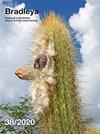Are endangered cacti safe in Brazil?
IF 1.2
4区 生物学
Q3 PLANT SCIENCES
引用次数: 3
Abstract
Summary: In situ conservation is an effective way to conserve living organisms, particularly endangered species. One way to encourage and guarantee in situ conservation is the creation of Conservation Units. Thus, this study points out which endangered cacti are protected in these Conservation Units and which are living in unprotected areas. Furthermore, we also discuss the effectiveness of these different types of Conservation Units in protecting these endangered cacti. Initially, we made up a list of all Cactaceae species in Brazil to assign their respective extinction risk category. This list was prepared according to the ‘Flora do Brasil’ database, the IUCN Red List of Threatened Species, and the book Cacti of Eastern Brazil. We only included cacti assigned to the Near Threatened, Vulnerable, Endangered and Critically Endangered categories. We also obtained information about the phytogeographic domain and Conservation Unit where cacti grow. There are 272 species and thirty-seven genera of the Cactaceae family in Brazil. Cacti grow in all six Brazilian phytogeographic domains. We found 135 species grouped into twenty-three genera threatened with extinction in Brazil. Parodia Speg. (nineteen species), Pilosocereus Byles & Rowley (sixteen species) and Rhipsalis Gaertn. (sixteen species) are the genera with the largest number of endangered species. There is no record of endangered cacti in the Amazon Rainforest. The largest number of endangered taxa are in the Cerrado (fifty-two taxa), Caatinga (fifty-one taxa), and Atlantic Forest (forty-eight taxa). We found that about 50% of these taxa grow in unprotected areas outside Conservation Units, which means that most endangered cacti are not safe in Brazil. If we do not take urgent protection actions for their conservation, many endangered cacti will be extinct from the wild in a few years in Brazil.濒临灭绝的仙人掌在巴西安全吗?
摘要:就地保护是保护生物,特别是濒危物种的有效方法。鼓励和保障就地保护的一种方法是建立保护单位。因此,本研究指出了哪些濒危仙人掌在这些保护区受到保护,哪些生活在未受保护的地区。此外,我们还讨论了这些不同类型的保护单位在保护这些濒危仙人掌方面的有效性。最初,我们列出了巴西所有仙人掌科物种的名单,以划分它们各自的灭绝风险类别。这份名单是根据“巴西植物群”数据库、世界自然保护联盟濒危物种红色名录和《巴西东部仙人掌》一书编制的。我们只将仙人掌分为近危、易危、濒危和极度濒危类别。我们还获得了有关仙人掌生长的植物地理区域和保护单位的信息。巴西仙人掌科共有37属272种。仙人掌生长在巴西所有六个植物地理区域。我们在巴西发现了有灭绝危险的23属135种物种。Parodia Speg。(19种)、Pilosocereus Byles&Rowley(16种)和Rhipsalis Gaertn。(十六种)是濒危物种最多的属。亚马逊雨林中没有濒危仙人掌的记录。濒危类群数量最多的是塞拉多(五十二个类群)、卡廷加(五十一个类群)和大西洋森林(四十八个类群)。我们发现,这些分类群中约有50%生长在保护区以外的无保护区,这意味着最濒危的仙人掌在巴西是不安全的。如果我们不采取紧急保护行动来保护它们,巴西的许多濒危仙人掌将在几年内从野外灭绝。
本文章由计算机程序翻译,如有差异,请以英文原文为准。
求助全文
约1分钟内获得全文
求助全文
来源期刊

Bradleya
PLANT SCIENCES-
CiteScore
2.80
自引率
25.00%
发文量
43
审稿时长
>12 weeks
期刊介绍:
Bradleya is the BCSS contribution to the scientific world and is accepted as such because of its academic standards. It can only flourish with the support of BCSS members, many of whom subscribe to it each year. The aim is to include articles which our members will find interesting and educational, whilst retaining rigorous standards of publication. Scientifically important articles don''t have to be dull to read. So, because Bradleya depends the subscriber, the editor endeavours to make its contents accessible, easily understood and enjoyable for all.
 求助内容:
求助内容: 应助结果提醒方式:
应助结果提醒方式:


